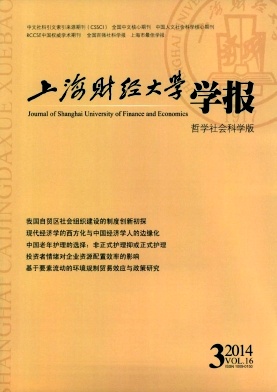投资者情绪对企业资源配置效率的影响——基于过度投资的视角
上海财经大学学报 2014 年 第 16 卷第 03 期, 页码:86 - 94
摘要
参考文献
摘要
文章从过度投资的视角研究了投资者情绪对企业资源配置效率的影响,并进一步考察了何种类型企业的过度投资行为更易受投资者情绪的影响。基于中国沪深两市上市公司1998-2010年的样本数据,文章的实证结果显示,在中国市场上投资者情绪对公司过度投资有显著为正的影响;拥有越多自由现金流量的公司,其过度投资行为受投资者情绪的影响程度越高;而融资约束程度越高的公司,其过度投资行为受投资者情绪的影响程度越低。这一研究发现拓展了对投资者情绪影响公司投资行为经济后果的研究,有助于我们更好地从微观视角理解金融市场的非理性是如何影响企业的资源配置效率,乃至影响到整个实体经济的发展。
[1]郝颖,刘星.股权融资依赖与企业投资行为——基于行为公司财务视角[J].经济与管理研究,2009,(5).
[2]花贵如,刘志远,许骞.投资者情绪、企业投资行为与资源配置效率[J].会计研究,2010,(11).
[3]黄乾富,沈红波.债务来源、债务期限结构与现金流的过度投资[J].金融研究,2009,(9).
[4]李科,徐龙炳.资本结构、行业竞争与外部治理环境[J].经济研究,2009,(6).
[5]连玉君,苏治.融资约束、不确定性与上市公司投资效率[J].管理评论,2009,(1).
[6]屈文洲,谢雅璐,叶玉妹.信息不对称、融资约束与投资—现金流敏感性——基于市场微观结构理论的实证研究[J].经济研究,2011,(6).
[7]吴世农,汪强.迎合投资者情绪?过度保守?还是两者并存——关于公司投资行为的实证研究[J].公司治理评论,2009,(1).
[8]辛清泉,林斌,王彦超.政府控制、经理薪酬与资本投资[J].经济研究,2007,(8).
[9]俞红海,徐龙炳,陈百助.终极控股股东控制权与自由现金流过度投资[J].经济研究,2010,(8).
[10]朱红军,何贤杰,陈信元.金融发展、预算软约束与企业投资[J].会计研究,2006,(10).
[11]Baker M.,Stein J.,Wurgler J.When Does the Market Matter?Stock Prices and the Investment of EquityDependent Firms[J].Quarterly Journal of Economics,2003,118:969-1006.
[12]Chang X.,Tam L.,Tan T.J.,Wong G.The Real Impact of Stock Market Mispricing:Evidence From Australia[J].Pacific-Basin Finance Journal,2007,15:388-408.
[13]Chang X.,Dasgupta S.,Wong G.Internal Cash Flows,Firm Valuation,and the Simultaneity of Corporate Policies[R].Working Paper,2010.
[14]Chirinko R.S.,Schaller H.Glamour vs.Value:The Real Story[R].Working Paper,Emory University,2006.
[15]Dong M.,Hirshleifer D.,Teoh S.H.Stock Market Misevaluation and Corporate Investment[J].Working Paper,York University,University of California,2007.
[16]Fazzari S.M.,Hubbard R.G.,Petersen B.C.Financing Constraint and Corporate Investment[R].Brookings Papers on Economic Activity,1988:141-195.
[17]Fazzari S.M.,Hubbard R.G.,Petersen B.C.Investment Cash Flow Sensitivities Are Useful:A Comment on Kaplan and Zingales[J].Quarterly Journal of Economics,2000,115:695-706.
[18]Goyal V.K.,Yamada T.Asset Price Shocks,Financial Constraints,and Investment:Evidence From Japan[J].Journal of Business,2004,77:175-200.
[19]Gilchrist S.,Himmelberg C.,Huberman G.Do Stock Price Bubbles Influence Corporate Investment[J].Journal of Monetary Economics,2005,52:805-827.
[20]Heinkel R.,Zechner J.The Role of Debt and Preferred Stock as a Solution To Adverse Investment Incentives[J].Journal of Financial and Quantitative Analysis,1990,25:1-24.
[21]Holmen M.,Hogfeldt P.Pyramidal Discounts:Tunneling or Overinvestment[J].International Review of Finance,2009,9:133-175.
[22]Jensen M.Agency Costs of Free Cash Flow,Corporate Finance and Takeovers[J].American Economic Review,1986,76:324-329.
[23]Myers S.C.,Majluf N.S.Corporate Financing and Investment Decision When Firms Have Information that Investors Do Not Have[J].Journal of Financial Economics,1984,13:184-221.
[24]Narayanan M.P.Debt Versus Equity Under Asymmetric Information[J].Journal of Financial and Quantitative Analysis,1988,23:39-51.
[25]Polk C.,Sapienza P.The Stock Market and Corporate Investment:A Test of Catering Theory[J].Review of Financial Studies,2009,11:187-217.
[26]Richardson S.Over-invesment of Free Cash Flow[J].Review of Accounting Studies,2006,11:159-189.
[27]Rhodes-Krof M.,Robinson D.,Viswanathan S.Valuation Waves and Merger Activity:The Empirical Evidence[J].Journal of Financial Economics,2005,77:561-604.
[28]Schaller H.Asymmetric Information,Liquidity Constraints and Canadian Investment[J].Canandian Journal of Economics,1993,26:552-574.
[29]Shin H.H.,Kim Y.H.Agency Costs and Efficiency of Business Capital Investment:Evidence from Quarterly Capital Expenditures[J].Journal of Corporate Finance,2002,8:139-158.
[30]Stulz R.Managerial Discretion and Optimal Financing Policies[J].Journal of Financial Economics,1990,26:3-27.
[31]Vogt S.The Cash Flow/Investment Relationship:Evidence From U.S.Manufacturing Firms[J].Financial Management,1994,23:3-20.
①本文中的投资者情绪是指投资者对未来预期的系统性偏差,是股票错误定价的同义词,两者可以互相替换。
①因为样本中剔除了金融业,所以剩下的5个行业分别是公用事业(0002)、房地产(0003)、综合(0004)、工业(0005)和商业(0005)。这里之所以没有选择国内研究中惯常使用的证监会行业分类,是因为这里需要对每个行业每年的样本数据进行回归,若按证监会行业分类,那么有些行业当年的样本数据不足20个,可能会导致小样本偏差。另外,因为在式(4)中用到示性函数I(
①由于篇幅所限,KZ指数的构建过程和数据刊略,如有读者需要请与作者联系。
[2]花贵如,刘志远,许骞.投资者情绪、企业投资行为与资源配置效率[J].会计研究,2010,(11).
[3]黄乾富,沈红波.债务来源、债务期限结构与现金流的过度投资[J].金融研究,2009,(9).
[4]李科,徐龙炳.资本结构、行业竞争与外部治理环境[J].经济研究,2009,(6).
[5]连玉君,苏治.融资约束、不确定性与上市公司投资效率[J].管理评论,2009,(1).
[6]屈文洲,谢雅璐,叶玉妹.信息不对称、融资约束与投资—现金流敏感性——基于市场微观结构理论的实证研究[J].经济研究,2011,(6).
[7]吴世农,汪强.迎合投资者情绪?过度保守?还是两者并存——关于公司投资行为的实证研究[J].公司治理评论,2009,(1).
[8]辛清泉,林斌,王彦超.政府控制、经理薪酬与资本投资[J].经济研究,2007,(8).
[9]俞红海,徐龙炳,陈百助.终极控股股东控制权与自由现金流过度投资[J].经济研究,2010,(8).
[10]朱红军,何贤杰,陈信元.金融发展、预算软约束与企业投资[J].会计研究,2006,(10).
[11]Baker M.,Stein J.,Wurgler J.When Does the Market Matter?Stock Prices and the Investment of EquityDependent Firms[J].Quarterly Journal of Economics,2003,118:969-1006.
[12]Chang X.,Tam L.,Tan T.J.,Wong G.The Real Impact of Stock Market Mispricing:Evidence From Australia[J].Pacific-Basin Finance Journal,2007,15:388-408.
[13]Chang X.,Dasgupta S.,Wong G.Internal Cash Flows,Firm Valuation,and the Simultaneity of Corporate Policies[R].Working Paper,2010.
[14]Chirinko R.S.,Schaller H.Glamour vs.Value:The Real Story[R].Working Paper,Emory University,2006.
[15]Dong M.,Hirshleifer D.,Teoh S.H.Stock Market Misevaluation and Corporate Investment[J].Working Paper,York University,University of California,2007.
[16]Fazzari S.M.,Hubbard R.G.,Petersen B.C.Financing Constraint and Corporate Investment[R].Brookings Papers on Economic Activity,1988:141-195.
[17]Fazzari S.M.,Hubbard R.G.,Petersen B.C.Investment Cash Flow Sensitivities Are Useful:A Comment on Kaplan and Zingales[J].Quarterly Journal of Economics,2000,115:695-706.
[18]Goyal V.K.,Yamada T.Asset Price Shocks,Financial Constraints,and Investment:Evidence From Japan[J].Journal of Business,2004,77:175-200.
[19]Gilchrist S.,Himmelberg C.,Huberman G.Do Stock Price Bubbles Influence Corporate Investment[J].Journal of Monetary Economics,2005,52:805-827.
[20]Heinkel R.,Zechner J.The Role of Debt and Preferred Stock as a Solution To Adverse Investment Incentives[J].Journal of Financial and Quantitative Analysis,1990,25:1-24.
[21]Holmen M.,Hogfeldt P.Pyramidal Discounts:Tunneling or Overinvestment[J].International Review of Finance,2009,9:133-175.
[22]Jensen M.Agency Costs of Free Cash Flow,Corporate Finance and Takeovers[J].American Economic Review,1986,76:324-329.
[23]Myers S.C.,Majluf N.S.Corporate Financing and Investment Decision When Firms Have Information that Investors Do Not Have[J].Journal of Financial Economics,1984,13:184-221.
[24]Narayanan M.P.Debt Versus Equity Under Asymmetric Information[J].Journal of Financial and Quantitative Analysis,1988,23:39-51.
[25]Polk C.,Sapienza P.The Stock Market and Corporate Investment:A Test of Catering Theory[J].Review of Financial Studies,2009,11:187-217.
[26]Richardson S.Over-invesment of Free Cash Flow[J].Review of Accounting Studies,2006,11:159-189.
[27]Rhodes-Krof M.,Robinson D.,Viswanathan S.Valuation Waves and Merger Activity:The Empirical Evidence[J].Journal of Financial Economics,2005,77:561-604.
[28]Schaller H.Asymmetric Information,Liquidity Constraints and Canadian Investment[J].Canandian Journal of Economics,1993,26:552-574.
[29]Shin H.H.,Kim Y.H.Agency Costs and Efficiency of Business Capital Investment:Evidence from Quarterly Capital Expenditures[J].Journal of Corporate Finance,2002,8:139-158.
[30]Stulz R.Managerial Discretion and Optimal Financing Policies[J].Journal of Financial Economics,1990,26:3-27.
[31]Vogt S.The Cash Flow/Investment Relationship:Evidence From U.S.Manufacturing Firms[J].Financial Management,1994,23:3-20.
①本文中的投资者情绪是指投资者对未来预期的系统性偏差,是股票错误定价的同义词,两者可以互相替换。
①因为样本中剔除了金融业,所以剩下的5个行业分别是公用事业(0002)、房地产(0003)、综合(0004)、工业(0005)和商业(0005)。这里之所以没有选择国内研究中惯常使用的证监会行业分类,是因为这里需要对每个行业每年的样本数据进行回归,若按证监会行业分类,那么有些行业当年的样本数据不足20个,可能会导致小样本偏差。另外,因为在式(4)中用到示性函数I(
①由于篇幅所限,KZ指数的构建过程和数据刊略,如有读者需要请与作者联系。
引用本文
崔晓蕾, 何婧, 徐龙炳. 投资者情绪对企业资源配置效率的影响——基于过度投资的视角[J]. 上海财经大学学报, 2014, 16(3): 86–94.
导出参考文献,格式为:
本期封面
相关论文





 8727
8727  729
729

